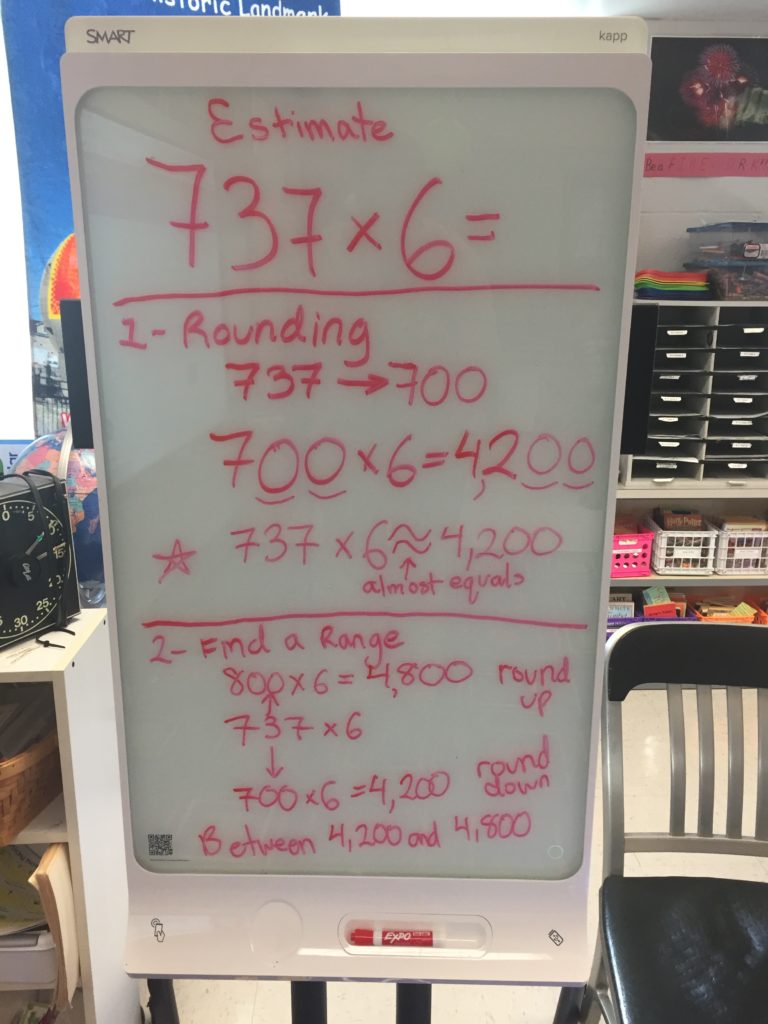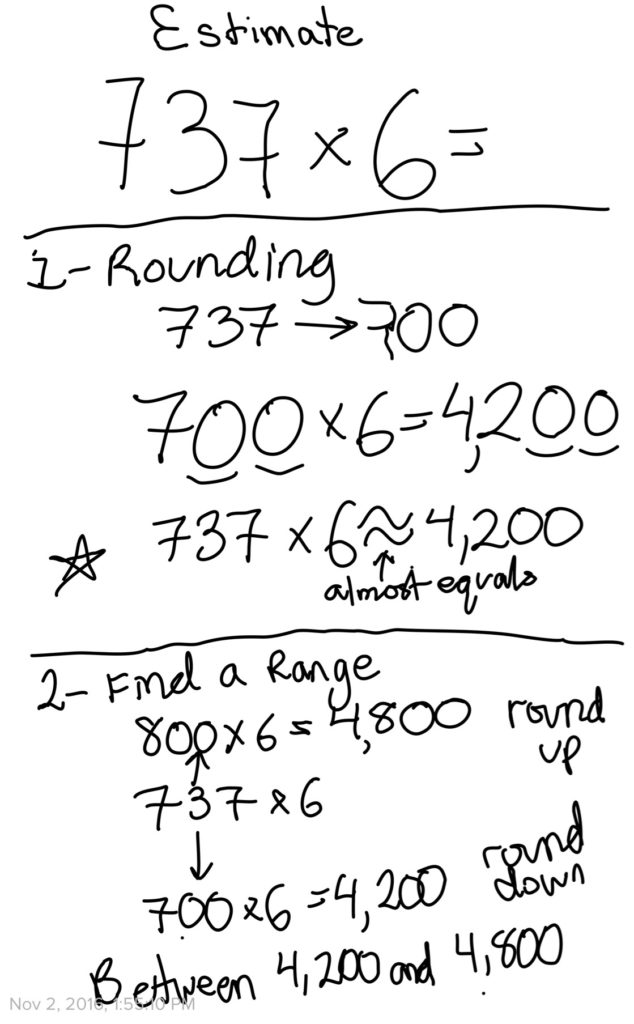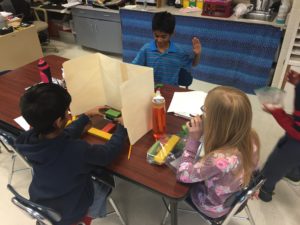Viewing: points
January 7, 2018
Supporting Students’ Choices
Hello, families! One of my focuses this year has been helping students to make the best possible choices in class. As a group, we’ve been working to curtail side conversations, increase direction following, and improve the amount of respect in the classroom. In early December, I launched some new approaches, and I’m so happy to say that these have been very helpful in making our classroom a more focused, kind, and positive space for learning. These new approaches include three parts:
Our Goals
Like every other class at PGS, we have a social contract that outlines how students and teachers want to be treated by one other. While it has many important qualities included in it, I found that it lacked the specificity needed to give us precise goals. For example, the idea of respect was included in our social contract, but it didn’t outline what respect is, what it looks like, how it makes us feel, etc. So, through some discussions with students, I developed a new set of goals for our class. Before you look at it, let me warn you: It looks like a lot. But in fact, it’s not as complicated as it seems.
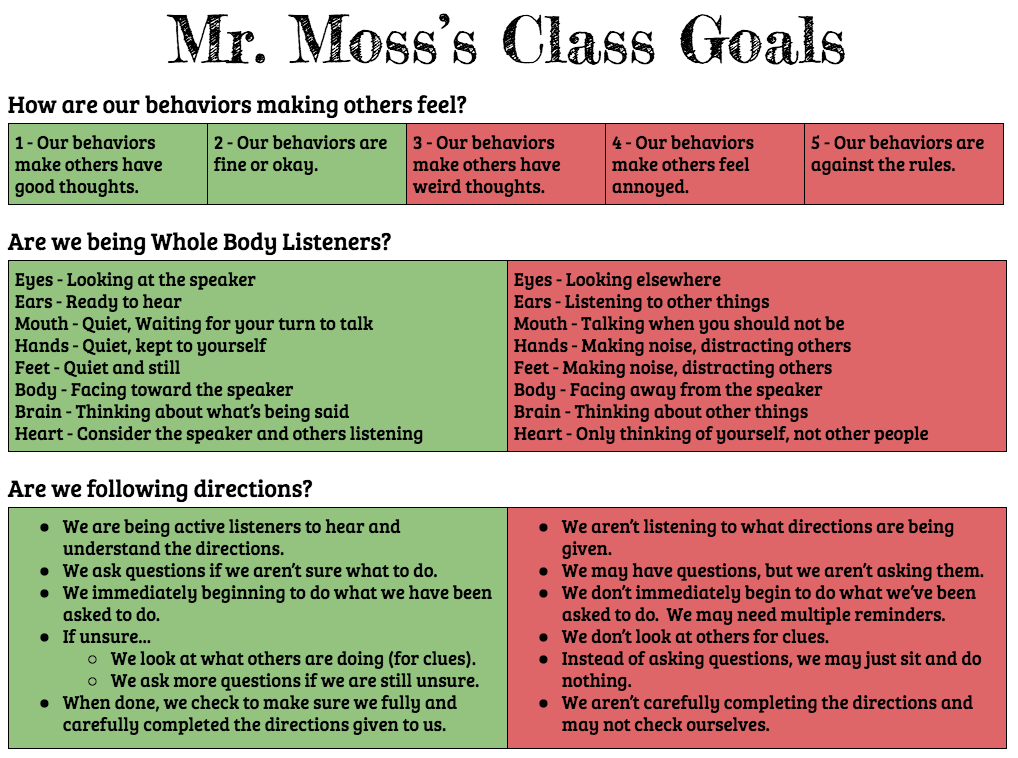 Our new class goals, pictured left, focus on three different areas of our social contract that we (as a group) felt were challenges: respect, focus, and in-control. Using those areas as starting points, we discussed what those qualities looked like and felt like. For “How are our behaviors making others feel?” we use a rating scale that has been very helpful to us throughout the year. Rather than rating the behaviors themselves, this scale focuses on how others feel about our behaviors. Students are VERY familiar with this and can quickly identify whether a behavior is desirable (leading to a 1 or 2 feeling in others) or undesirable (resulting in a 3, 4, or 5 feeling in others). This rating scale came from the game “Should I or Shouldn’t It?”, by Social Thinking, which poses social situations that students must respond to. Some are black and white, like feeling hungry, and taking a snack off a friend’s desk. (A 4 or 5 for sure!) But others are quite a bit more gray, like hearing the doorbell ring and opening the door on your own because your mom didn’t hear it in the other room. (Is it a 1 or 2 because you helped your mom by answering the door? Is it a 5 because you aren’t allowed to open the door? Somewhere in between?)
Our new class goals, pictured left, focus on three different areas of our social contract that we (as a group) felt were challenges: respect, focus, and in-control. Using those areas as starting points, we discussed what those qualities looked like and felt like. For “How are our behaviors making others feel?” we use a rating scale that has been very helpful to us throughout the year. Rather than rating the behaviors themselves, this scale focuses on how others feel about our behaviors. Students are VERY familiar with this and can quickly identify whether a behavior is desirable (leading to a 1 or 2 feeling in others) or undesirable (resulting in a 3, 4, or 5 feeling in others). This rating scale came from the game “Should I or Shouldn’t It?”, by Social Thinking, which poses social situations that students must respond to. Some are black and white, like feeling hungry, and taking a snack off a friend’s desk. (A 4 or 5 for sure!) But others are quite a bit more gray, like hearing the doorbell ring and opening the door on your own because your mom didn’t hear it in the other room. (Is it a 1 or 2 because you helped your mom by answering the door? Is it a 5 because you aren’t allowed to open the door? Somewhere in between?)
The second goal focuses on whole body listening. While that may sound silly to you, it’s helpful in showing students exactly what’s expected of them. (We have a dandy poster in class that lists these qualities in a more visually clear, approachable manner.) Finally, the third goal focuses on following directions, which should be self-explanatory.
So while you may look at these goals and find yourself taken aback by all the wording, please understand that these ideas are very familiar to students, and they typically don’t NEED to review the detailed language. Unified arts teachers have reported to me that their times with our class have also improved since we started using these goals. (They all have their own copies to use with our students.)
At the end of an activity, we reflect on how the activity went. We discuss the choices students made (as a group) and how everyone felt based on the behaviors of those around them. (Again, this may sound a bit cheesy, but it’s working!) If we agree that the class fell into the green zone for all three questions, the class earns a point.
Points
Small goals help students to see the success of their choices on a more consistent basis. When we started this, we identified the number of opportunities students have on a given day to earn points, and we estimated that the class can potentially earn as many as eight or nine points on a given day. So, to start, we set a goal of 25 points for earning a pajama day! Little did I know how quickly we’d reach our goal, and the kids earned their points right near our school-organized pajama day fundraiser for CCMC. So we switched to popsicles. (I confess, I’ve been dragging my heels on this. It took me a few days to get the popsicles, and then after being out for a death in the family, vacation, and the snow days, we haven’t yet gotten to enjoy the treats. This week for sure!) Now, students are working to earn 50 points for a movie opportunity! The speed at which the class earns points has slowed a bit as the novelty has worn off (and that’s entirely typical), but we’re getting there!
Blurt Blocks
Our class is a community, and in that spirit, I like to focus on class successes. That’s why the group earns points for overall success. But I recognize that it’s important for students to be individually accountable as well. I continue to offer chance tickets to students who are making admirable choices in class, but I added in something new to support students when they’re not making appropriate choices: Blurt Blocks. If a student isn’t acting appropriately in class, I give him or her a Blurt Block. They’re little plastic blocks, and if a student receives a Blurt Block, they have to hold them in their hand (or keep them close by, if they need their hands for a learning activity). These aren’t intended to be an embarrassment for students. Rather, they serve as a tangible reminder that the student needs to change his or her behavior. If a student receives two Blurt Blocks during a single activity, he or she completed a letter home to his/her parent(s) about what happened and what needs to improve. That letter must be signed and returned to school the next day. At the end of an activity, when we look at whether we met our goals, students return any Blurt Blocks they received and start fresh for the next activity.
Overall, these three new approaches have been very helpful in improving our class environment. The overall mood in the classroom is more peaceful and focused, and we’ve been much more productive in recent weeks.
If you have any questions about our new approaches, please feel free to contact me.
Posted in Class Updates|By Jon Moss
November 2, 2016
What’s New in November?
As much as I love watching the fall foliage in October, I must admit that I am relieved that it’s over! Two district curriculum meetings, one conference presentation, 26 DRAs (and counting), and plenty of other projects made October a productive but exhausting month! As I dig out from the month that seemingly never ended, I’m looking forward and am excited to share three new things happening in our classroom!
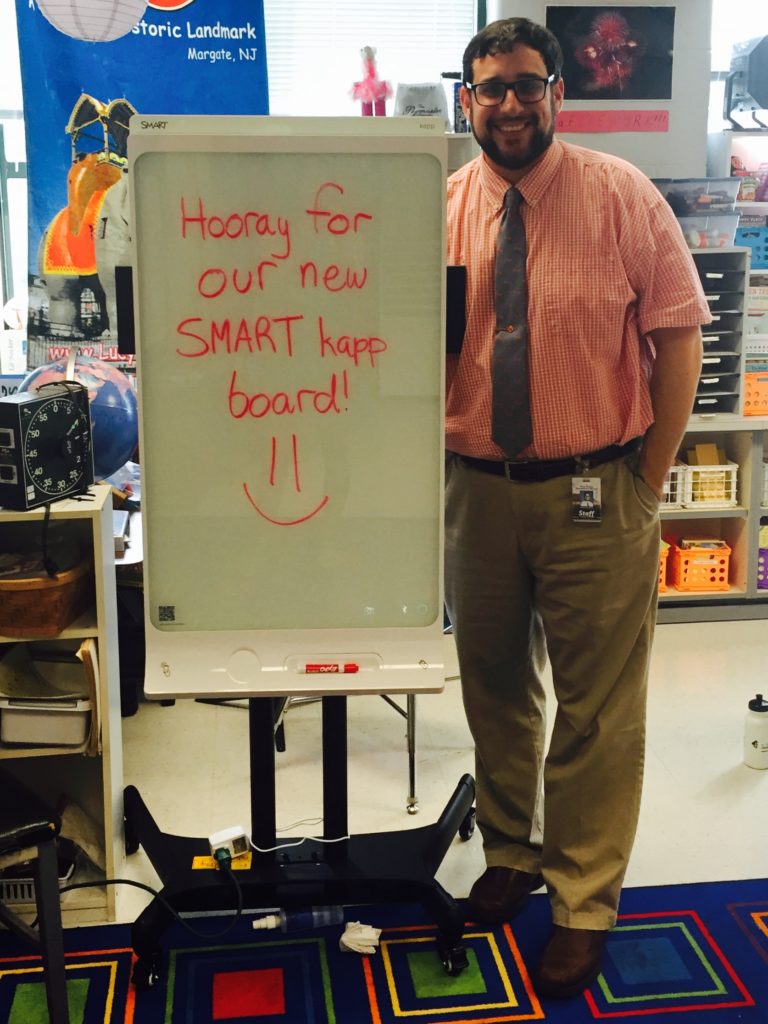 Last Tuesday, I presented at the 2016 CECA/CASL conference about how to integrate collaborative eLearning into classroom instruction. (If you’re interested in learning more about my conference presentation, visit my Teachers and Technology link up top, or click here.) I think it was my lucky day, as I ended up leaving with a new document camera for our classroom and an interactive whiteboard setup (evaluation products from a vendor we’ve used in the past), and a bag of books from a raffle. But my big win was being randomly chosen to receive a “SMART kapp” board for our classroom! SMART kapp is a dry erase board that can capture a snapshot of what’s written on it. By pairing it with my phone, I’m able to take what’s written and upload it to Google Drive (to share in Google Classroom), save it as a PDF or JPG image, and more. I’m excited by its potential to let me share notes from class with students and families in order to support homework. After ordering and assembling a stand, I was excited to try it out today for the first time, and so far, I’m impressed! We used it for a math lesson today, and I uploaded our notes to Google Classroom for the students to use this evening. It’s still new, so we’ll see how it best helps us in class, but I welcome and appreciate your feedback! Here’s a sample of how it looks in real and recorded images:
Last Tuesday, I presented at the 2016 CECA/CASL conference about how to integrate collaborative eLearning into classroom instruction. (If you’re interested in learning more about my conference presentation, visit my Teachers and Technology link up top, or click here.) I think it was my lucky day, as I ended up leaving with a new document camera for our classroom and an interactive whiteboard setup (evaluation products from a vendor we’ve used in the past), and a bag of books from a raffle. But my big win was being randomly chosen to receive a “SMART kapp” board for our classroom! SMART kapp is a dry erase board that can capture a snapshot of what’s written on it. By pairing it with my phone, I’m able to take what’s written and upload it to Google Drive (to share in Google Classroom), save it as a PDF or JPG image, and more. I’m excited by its potential to let me share notes from class with students and families in order to support homework. After ordering and assembling a stand, I was excited to try it out today for the first time, and so far, I’m impressed! We used it for a math lesson today, and I uploaded our notes to Google Classroom for the students to use this evening. It’s still new, so we’ll see how it best helps us in class, but I welcome and appreciate your feedback! Here’s a sample of how it looks in real and recorded images:
Our second “New in November” item is math rotations. This may be familiar to you from third grade. Traditional math lessons take about 60 minutes and may be comprised of 40 minutes of whole class 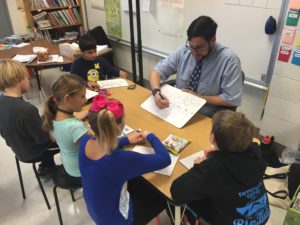 instruction and 20 minutes of independent or small group practice. What’s tough about that is that in that 40 minutes, there are students who are ready to move on after 10 minutes, and students who need more support beyond what was already taught. At PGS, we’re working to be more responsive to student needs, so we use math stations to better differentiate our instruction. The whole class lesson is shorter, only 15 or 20 minutes, and then students split up into assigned groups for math rotations. Students visit four stations in a given day: the teacher station (for small group, customized instruction about the skill I introduced in the minilesson), the practice station (for practice with that same skill), the hands-on station (where there is a game or other fun activity to let students reinforce various math skills), and the fluency station (where students work to maintain their computational fluency – aka adding and subtracting and later, multiplying and dividing).
instruction and 20 minutes of independent or small group practice. What’s tough about that is that in that 40 minutes, there are students who are ready to move on after 10 minutes, and students who need more support beyond what was already taught. At PGS, we’re working to be more responsive to student needs, so we use math stations to better differentiate our instruction. The whole class lesson is shorter, only 15 or 20 minutes, and then students split up into assigned groups for math rotations. Students visit four stations in a given day: the teacher station (for small group, customized instruction about the skill I introduced in the minilesson), the practice station (for practice with that same skill), the hands-on station (where there is a game or other fun activity to let students reinforce various math skills), and the fluency station (where students work to maintain their computational fluency – aka adding and subtracting and later, multiplying and dividing).
There is a set order for these rotations, so for many students, they’re having a 15 or 20 minute minilesson, immediately followed by a 10(ish) minute small group session to work on the same skill. This seems like less time, but the small group setting means that I can provide targeted instruction to students in a more meaningful, efficient way. Other students will see me after visiting one or two or three other stations, but this model ensures that everyone gets the support that he or she needs. Please understand that there are days in which we may not have math rotations, often when we’re introducing a new skill that warrants more time for whole class instruction.
Our final “New in November” is a shift in our class’ conduct system. For the first few weeks of school, groups competed to earn points, and the group with the most points on Friday would earn a few minutes of free time. This works well, and while the friendly competition generally stayed friendly, I wanted to raise the bar for the students. Starting this month, we’re shifting to a cooperative model. Groups are still working to earn points for their team, and we may still have the winning group receive their prize, but the class is working toward a larger goal, too. When ALL the groups have earned 50 points (each), the class will earn a theme day, such as pajama day, 80’s day, etc. That means that in addition to students within a group helping their teammates to make good choices, we also have each group helping one another. The prize won’t come until each group reaches 50, so there’s an incentive for students to support one another in order to achieve their shared goal.
As always, if you have any questions, please feel free to contact me!
Posted in Class Updates|By Jon Moss

